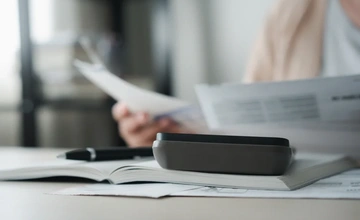There are lots of ways to budget your money and pay back what you owe. Some can feel tricky, but others are more straightforward – like the 50/30/20 rule. So, what is it, and could it work for you?
How the 50/30/20 rule works
The 50/30/20 rule splits your money into three simple pots: your needs, your wants, and your savings and debt repayments.
- The ‘needs’ pot (50%) – This covers the things you can’t do without. Think rent or mortgage, Council Tax, gas and electric bills, groceries, and travel to work.
- The ‘wants’ pot (30%) – This is for the nice-to-haves. Takeaways, nights out, streaming services, holidays or new clothes all fit here. Try to be honest with yourself – some clothes may be needed, but not all of them!
- The ‘savings and repayments’ pot (20%) – This is where you put money aside for savings or to repay things like credit cards, loans or overdrafts. It doesn’t include agreements like secured loans or car finance – those count as ‘needs’.
Here’s a quick example
Let’s say you take home £2,000 a month after tax. The rule would split your money like this:
- £1,000 for needs
- £600 for wants
- £400 for savings or debt repayments
If your income changes month to month – for example, if you’re self-employed – try using the average of your last three months to guide your pots. You could check your bank statements or accounting app to help you work this out.
Is the 50/30/20 method right for you?
Lots of people find this method helpful. Here’s why it might work for you:
- You could pay off your debts quicker – If your 20% pot covers more than the minimum payment, you can pay more and clear your balance faster. That means less interest over time. Not sure which debts to focus on first? See whether the snowball or avalanche method could help.
- You might save more – Once your debts are covered, any extra from that 20% can go straight into a savings pot. You could build an emergency fund or save up for something big, like a house deposit or holiday.
- You still get to enjoy yourself – Because the rule sets aside money for treats, you don’t need to feel guilty about the odd meal deal or takeaway, knowing your bills and savings are already sorted.
When might it not work?
The 50/30/20 rule isn’t a one-size-fits-all. It might not work for you if:
- Your needs cost more than 50% – This is really common, especially with high rent or energy bills. If so, it’s fine to change the split. Your version might be 70/20/10, and that’s okay!
- You like more detailed budgeting – Some people want to track every penny. You might prefer something like zero-based budgeting instead.
- Your income goes up and down – If your earnings change a lot, you might find it hard to stick to fixed percentages. You can still use the method as a guide – just tweak the pots each month.
- You want to save more – Maybe you’ve got a big goal, like buying a home or retiring early. You could flip the rule to 50/20/30, or even 50/10/40. It’s all about what works for you.
- You feel pressure to spend – If you’ve set aside £600 for wants, you might feel you should spend it. But there’s no need to use every penny – if there’s leftover cash, you can save it or pay off more debt.
Tips to help you stick to your pots
Even simple budgeting can be tough to stick to at first. Here are a few tips that might help:
- Use a budgeting app – Apps like Snoop, Emma or Moneyhub help track your spending and show you how your money is split.
- Automate your savings – Set up a standing order to move money into savings or debt repayments just after payday.
- Try jam-jar budgeting – Physically split your money into different pots or use online banking tools like Monzo’s pots or Starling’s Spaces.
- Set reminders – A quick weekly check-in helps you stay on track.
If none of these methods work and you still can’t cover your essentials, it’s worth getting free support. MoneyHelper has great guides on managing your money and StepChange offers free debt advice with no judgement.
Is the 50/30/20 rule worth a try?
The 50/30/20 rule is a helpful way to budget if you want something simple and flexible. It can help you cover the important stuff, enjoy life a little, and still make progress with your savings and debts.
But if it doesn’t quite fit, don’t worry – there are lots of other ways to manage your money.
Take a look at our money management guides for more advice on how to get the most out of your finances.
Fiona is a personal finance writer with over 7 years’ experience writing for a broad range of industries before joining Ocean in 2021. She uses her wealth of experience to turn the overwhelming aspects of finance into articles that are easy to understand.
Find this useful? Share it with others!










